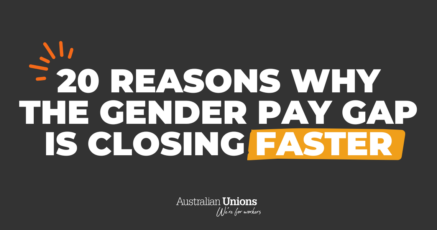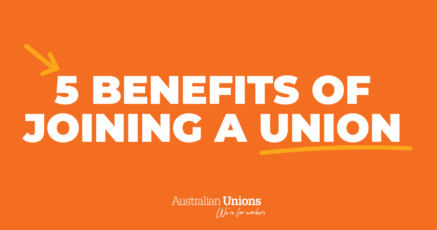Aboriginal and/or Torres Strait Islander peoples should be aware that this article contains the names of people who have passed away.
National Tertiary Education Union member and Guyinbaraay woman Dr Maree Gruppetta worked and campaigned in Australian universities. She was a driven activist who strongly advocated on union and Aboriginal matters.
Maree began her superannuation contributions when she was in her 40s. But when Maree had to undergo five years of cancer treatment – working all the while – she had sparse superannuation funds to cover her health treatment.
She relied on an insurance policy to cover the bills and to leave a legacy for her children and grandchildren.
Despite her serious illness, Maree maintained her strong standards and union membership, inspiring those who worked with her. She passed away in 2019 aged 55.
Maree is just one of hundreds of thousands of stories that show the cruel consequences of the gender and Indigenous superannuation gaps. But there is no reason why we can’t change these entrenched inequalities in our retirement system.
The gender superannuation gap
You may have already heard of the gender pay gap. But the structural discrimination that has created the gender pay gap also contributes to the gender superannuation gap where women disproportionately retire into poverty.
The gender pay gap number is often given as 13.8% but this figure only accounts for full time ordinary earnings. When bonuses are considered in addition to full time ordinary earnings that figure becomes 16.4%.
And if we recognise that 45% of women are in part-time jobs, working women experience a pay gap with men of almost 31%.
But beyond discrimination in pay, other structural factors also come into play.
Women are far more likely to come in and out of the workforce than men, taking time off to have a child or to do unpaid caring work. Women are also more likely to be insecure jobs which reduces the consistency with which working women can build up their superannuation.
At the end of the day, women are the ones paying the price for the gender discrimination they’ve experienced throughout their careers.
We have working women retiring into poverty and homelessness. Unless we tackle the gender super gap, it is estimated to last until at least 2061.
But the gender gap doesn’t exist in a vacuum. It is only one of the superannuation issues unions are working to address.
The Indigenous superannuation gap
Decades of systemic exclusion from fair wages and the ability to accumulate property, systemic and pervasive racism combined with cynical and discriminatory Government policy has left Aboriginal and Torres Strait Islanders with less means to accumulate superannuation than the general population.
We can see the devastating impacts of this colonial history in the average figures for superannuation balances.
Aboriginal and Torres Strait Islanders men have an average balance of $55,743 compared to $110,000 for non-Aboriginal and Torres Strait Islander men.
The compounding discriminatory factors can be seen in the balances for Aboriginal and Torres Strait Islander women. Their average super balance is $39,909 compared to $63,000 for non-Aboriginal and Torres Strait Islander women.
The lack of intergenerational wealth has not been factored into the superannuation system’s design which relies on the assumption of home ownership in its calculations for what forms a decent retirement.
This inequality faced by Aboriginal and Torres Strait Islander workers has been compounded in other ways too. First Nations people have also been required to work with fewer rights than non-Indigenous workers, for example through the former Government’s racist Community Development Programme (CDP).
The CDP targeted exclusively Indigenous areas, forced Aboriginal and Torres Strait Islanders to work for the dole or face significant penalties to their dole payments.
The work that was often done in unsafe conditions, workers were not protected by work health and safety programmes or insurance, and superannuation was not paid on top of wages earned.
But thanks to the campaigning of the First Nations Workers Alliance, we can expect to see the CDP replaced soon, as promised by the Albanese Government.
A dignified retirement for all
The Australian union movement has a fundamental goal that no worker should retire into poverty and instead should be entitled to a dignified retirement.
We need to address both the gender and Indigenous superannuation gap is to disrupt a system which, thus far, has perpetuated inequality stemming from dispossession and colonisation.
For starters, the preservation age for Aboriginal and Torres Strait Islander workers needs to be lowered as it has been set too high to be fair. Indigenous workers should not suffer while we close the life-expectancy gap, and they should be the ones to determine how they participate in the retirement income system.
We also need to reduce the documentation load required to prove kinship and require retirement-related services to provide information in-language where possible.
Other measures to reduce inequality in retirement include raising the Age Pension as well as JobSeeker.
Already, the union movement has taken huge steps in reducing superannuation inequality. Union members led a hard-fought, hard-won campaign that resulted in the abolition of the $450 per month earning threshold for compulsory superannuation.
The removal of the threshold will benefit around 300,000 low-paid workers, around two-thirds of which are women.
Women in unions also face a far smaller gender pay gap. The median male non-member earns $2.70 more per hour than his female equivalent, but for union members, this difference is only $1.00. Overall, women union members earn 32% more per week than women non-members.
Union members won’t rest until there is equality for all, and that means ensuring fair wages and decent retirement.
Australian Unions is made up of almost 2-million workers coming together to get things done. The louder our collective voice, the bigger the impact we can make.







SHARE:
How we can prevent women and Indigenous workers from retiring into poverty